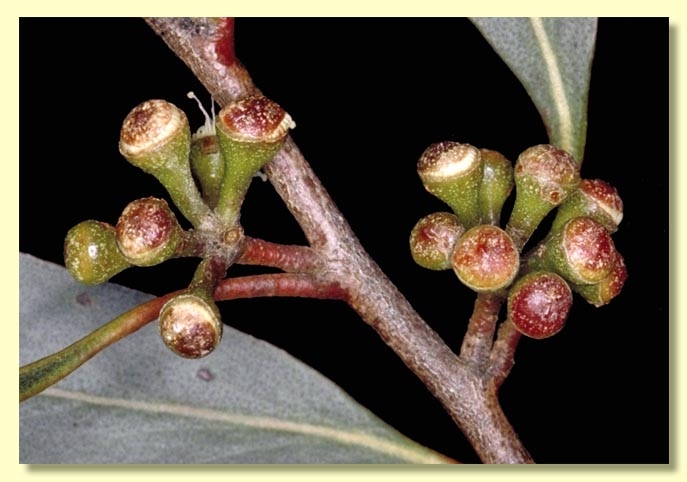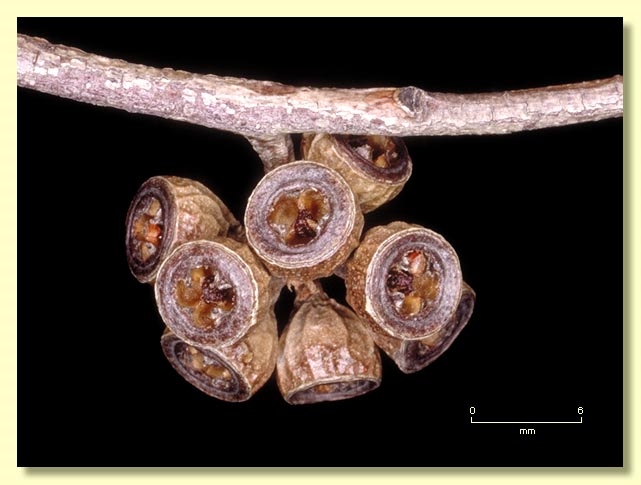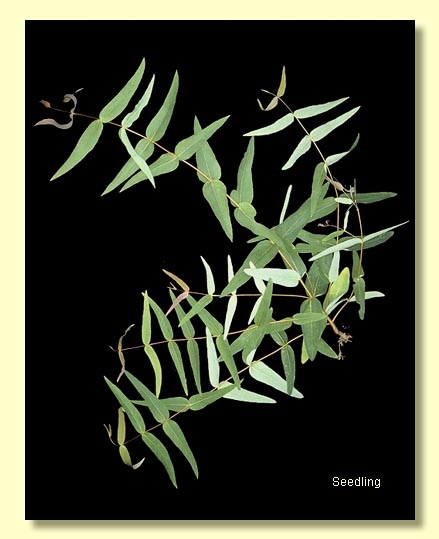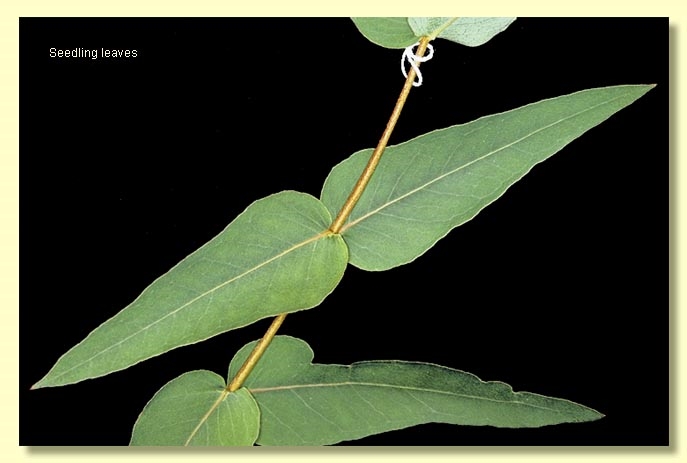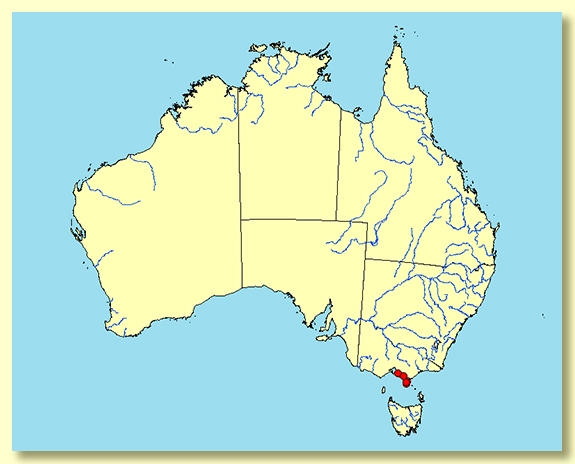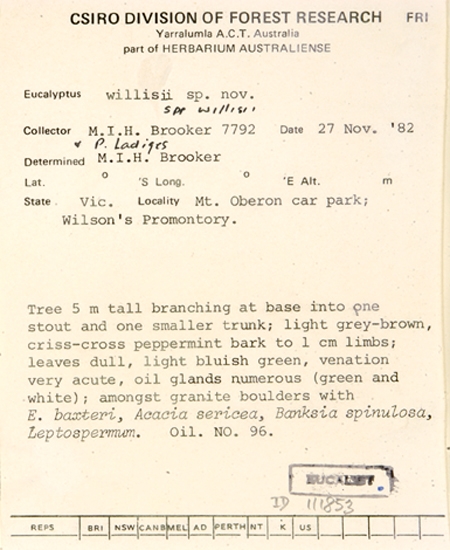Euclid - Online edition
Eucalyptus willisii subsp. willisii
Eucalyptus | Eucalyptus | Aromatica | Radiatae
T: Mt Oberon car park, Wilsons Promontory, Vic., 27 Nov. 1982, M.I.H.Brooker 7792 & P.Y.Ladiges; holo: MEL; iso: CANB, NSW.
[Eucalyptus vitrea auct. non R.T.Baker: A.J.Ewart, Fl. Victoria 617 (1930).]
[Eucalyptus nitida auct. non J.D.Hook.: J.H.Willis, Handb. Pl. Victoria 2: 415, 416 (1972).]
Bark rough and extending often to smallest branches, fibrous, peppermint-type, dark grey, or branches ca 5 cm diameter smooth, cream, pale grey or yellow-grey.
Juvenile growth (coppice or field seedlings to 50 cm): stem rounded in cross-section, smooth or warty; juvenile leaves opposite and sessile for many pairs, lanceolate to falcate, 6.4–8.5 cm long, 1.8–2.9 cm wide, bases stem-clasping, green.
Adult leaves alternate, petiole 0.6–1.8 cm long; blade lanceolate to falcate, 6–17 cm long, 0.7–2.3 cm wide, base tapering to petiole, concolorous, dull to only slightly glossy, blue-green to green, side-veins very acute or parallel to midrib, sparsely to moderately reticulate, intramarginal near margin, oil glands island.
Inflorescence axillary unbranched, peduncles 0.2–0.8 cm long, buds 11 to ?25 per umbel, with pedicels to 0.2–0.4 m long. Mature buds obovoid or clavate, 0.3–0.5 cm long, 0.3 cm wide, green to yellow, scar absent, operculum usually rounded, stamens inflexed, anthers reniform to cordate, versatile, dorsifixed, dehiscing by confluent slits, style shorter than bud cavity, stigma tapered, locules usually 4, the placentae each with 2 vertical ovule rows. Flowers white.
Fruit with pedicels 0.1–0.4 m long, cup-shaped or hemispherical, 0.4–0.6 cm long, 0.4–0.6 cm wide, disc slightly raised-convex to annular, or level, valves 4, near rim level or enclosed.
Seeds brown, 1–2.5 mm long, pyramidal or obliquely pyramidal, dorsal surface smooth, hilum terminal.
Cultivated seedlings (measured at ca node 10): cotyledons reniform; stems rounded in cross-section, warty, non-glaucous; leaves sessile, opposite for many nodes, lanceolate, 7.5–9 cm long, 2–2.5 cm wide, amplexicaul, margin entire, apex pointed, discolorous, dull to slightly glossy, green.
Flowering has been recorded in January, September, October, November and December.
Eucalyptus willisii is a species of small to medium-sized tree, or sometimes a mallee, found mainly in Victoria and of coastal distribution in South Gippsland particularly Wilsons Promontory extending west of Melbourne as far as the south-east of South Australia near Mount Gambier, with an inland extension into the Grampians of western Victoria (plants from the Gippsland Lakes hinterland once recognized as E. willisii are now regarded as being E. arenicola ). It occurs on poor sandy sites on foothills and gently undulating country. Its rough bark is finely fibrous and variable in extent, adult leaves dull to slightly glossy green, whilst juvenile leaves on coppice growth are sessile, lanceolate and opposite for many pairs. Buds are numerous per umbel, have rounded opercula and are never white waxy.
E. willisii is one of the peppermints which, as a group, are poorly speciated and difficult to identify. E. willisii has been variously attributed to E. radiata, E. nitida and E. sp. aff. dives. E. nitida is a Tasmanian endemic (but see extra note below). E. willisii differs from other Victorian peppermints by the generally hemispherical opercula and lack of visible white waxiness. The juvenile leaves of E. willisii are intermediate in dimensions between E. dives (ovate juveniles) and E. radiata (short linear to lanceolate juveniles).
There are two subspecies:
E. willisii subsp. willisii
Occurs east of Port Phillip Bay, with certainty at Wilsons Promontory and probably in the low undulating hinterland of Westernport Bay and on French Island. The plants are woodland trees with extensive rough bark and dull to scarcely glossy green to blue-green adult leaves 0.7–2.3 cm wide and fruit 0.4–0.6 cm wide. (Trees occurring to the north-east of Wilsons Promontory in the lowland Holey Plains area extending east to near Bairnsdale are E. arenicola, recently split from subsp. willisii and differ in having slightly larger more hemispherical fruit 0.5-0.9 cm wide and weakly glossy leaves). Lowland plants from Beechford and Lulworth in north coastal Tasmania may also match subsp. willisii but further study of these is needed (fide M.I.H. Brooker).
E. willisii subsp. falciformis
Has a coastal and subcoastal distribution from Aireys Inlet in Victoria to the west of Penola in South Australia, and also in the Grampians. Subsp. falciformis has coarser adult leaves almost always glosssy green and 1–3(3.5) cm wide, fruit 0.5–0.8 cm wide, and often falcate juvenile leaves. The rough bark is very variable in extent, from a short sock on younger multi-stemmed trees to completely covering trunk and larger branches. It is most likely to be confused with E. dives but differs in the juvenile leaves, lack of white wax and the variable rough bark. Plants from the Little Desert referred to by others as E. molyneuxii Rule are here regarded as Eucalyptus willisii subsp. falciformis.
Eucalyptus willisii belongs to Eucalyptus subgenus Eucalyptus section Aromatica (the peppermints) because the buds have a single operculum, anthers are reniform, ovules are in two rows, seeds are more or less pyramidal, adult leaf venation is acute to parallel and juvenile leaves are sessile and opposite for many pairs. Within this section six closely related species form series Radiatae, viz. E. elata, E. radiata (with three subspecies), E. croajingolensis, E. willisii (with two subspecies), E. arenicola and E. dives. They differ from each other in bark, leaf, bud and fruit characteristics but the distinctions are not always strong. As a group series Radiatae differs from the endemic Tasmanian peppermints, series Insulanae, by having numerous oil glands in the juvenile leaves (very few in the Tasmanian species).
Extra Notes 1
In a study by Rankin (1998) the identity of the type population of E. willisii at Wilsons Promontory was called into question. Rankin stated that these peppermints were in fact an isolated occurrence of the Tasmanian peppermint E. nitida. Rankin never formally published this and other conclusions in what was his Ph.D. thesis. If this is accepted then the peppermints elsewhere previously referred to E. willisii will need new names. In his thesis he referred to the peppermints occurring in the Holey Plains area and the low country around the Gippsland Lakes as "Eucalyptus sp. aff dives (Eastern Victoria)" but it was unclear from his thesis if he also included in it those foothill peppermint populations from the Tynong, Packenham and Gembrook areas nearer to Melbourne, and which are clearly not E. radiata (specimens from these areas held in CANB have been determined as being E. dives. Specimens formerly regarded as being E. willisii subsp. willisii from the Cranbourne area are now determined as E. radiata subsp. radiata). This confusion has now been partially resolved by the description of E. arenicola Rule for the Gippsland Lakes–Holey Plains trees (i.e. equivalent to Rankin's "Eucalyptus sp. aff dives (Eastern Victoria)".
Rankin (ibid.) refers to another taxon "Eucalyptus sp. aff dives (Western Victoria)" and it seems to cover the geographic range and morphology of the taxon E. wiillisii subsp. falciformis (described in 1986) exactly as given by us in EUCLID.
Extra Notes 2
Eucalyptus willisii subsp. willisii and E. arenicola: a synopsis based on specimens held at the Australian National Herbarium (CANB) .
Gippsland peppermint eucalypts occur from Wilsons Promontory (Prom) and nearby low coastal foothills, the Gippsland Plain (GP) from Rosedale east almost to Bairnsdale and south to the coastal heaths and woodlands from Yarram east to Loch Sport, on lowland sandy sites. The type locality for Eucalyptus willisii is Wilsons Promontory and for E. arenicola is near Loch Sport. The following plants are excluded: specimens from the Tynong, Gembrook, Packenham and Woori Yallock area are E. dives and those from Cranbourne are E. radiata subsp. radiata. Specimens from French Island (ACB 38278) and near Leongatha (AVS 3983) are included with the Prom specimens.
Using Australian National Herbarium (CANB) specimens, the following can be stated:
Fresh adult leaf colour/gloss as noted on label
Adult leaf main side-veins
Adult leaf width cm
Fruit length x width mm
Juvenile leaf length x width cm
Juvenile leaf
l:w ratio
No. CANB sheets measured
Prom
dull (rarely slightly glossy); blue-green to green (n=5)
acute, very acute, sub parallel
0.7-2.3
4-6 x 4-6
6.4-8.5 x 1.8-2.9
2.2-4.7
n=16 adult
n=2 juvenile
GP
slightly glossy (rarely dull); blue-green to green (n=6)
acute, very acute, sub parallel
0.7-1.8
4-6 x 5-8
6-9 x 1.4-2.7
3.1-6.4
n=19 adult
n=3 juvenile
Wilsons Promontory specimens have pretty much the same adult leaves as those from the Gippsland Plain area but those from the latter are more often slightly glossy. Adult leaf widths are virtually the same, and angle of side-veins is the same.
Plants from the GP sometimes have wider fruit than at the Prom but the dimensions are not exclusive.
Length: width ratios for juvenile leaves (field coppice) from GP show they can be narrower than those at the Prom but sample numbers are very few, and the ratios ranges overlap. Rule (2008) gives these dimensions for GP plants: juvenile leaves 5-11 x 0.8-1.6 cm but gives no ratios. Interestingly Rule also says fruits of GP plants are 7-9 mm wide (which is exclusive) but this is not the case with GP material in CANB.
Therefore to distinguish the two taxa one really needs juvenile leaves, geography and habitat, or perhaps fruit 7-9 mm wide.
Questions remain as to whether Eucalyptus willisii subsp. willisii occurs on undulating or lowland sites further west from the Prom especially around Leongatha, Westernport Bay and on French Island and perhaps parts of the Mornington Peninsula. Rule's contention that these peppermints are always E. radiata subsp. radiata is unconvincing especially in light of his comment about E. radiata subsp. radiata as having "usually dull blue-green adult leaves". In our experience the colour of the adult leaves of E. radiata subsp. radiata across its wide geographic range varies from light green to blue-green or grey-green and dull to weakly glossy, but never as glossy as the true adult leaves of E. dives.



